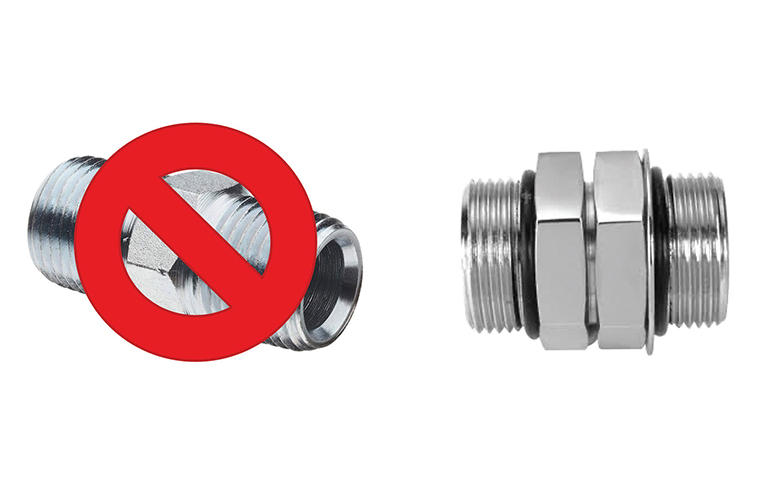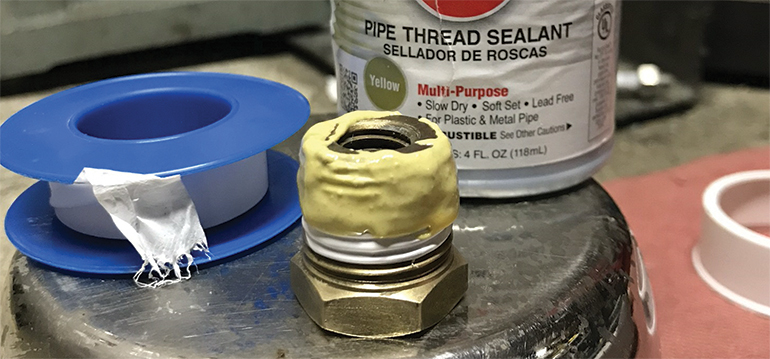By Josh Cosford, Contributing Editor
No matter how malevolent, some objects of desire seem to allure us despite our righteous awareness – diesel engines, plastic bags, Tik Tok. Indeed, we like to think that we always choose what’s best for our conscience when offered a choice, assuming we have one. Unfortunately, sometimes we indulge in the contrary and label our decision a guilty pleasure. Netflix binges, ice cream and Animal Crossing, are all benign, for the most part, but will be detrimental when taken to the extreme.
Just as in real life, there are undying habits in fluid power that really need euthanization. Suction filters, “flow makes it go,” and, you guessed it, NPT threads all need to go. I’ve written various articles lecturing you on the pitfalls of the first two mistakes, yet only briefly touched on the dangers of National Pipe Taper threads. Your death clock ticks, NPT. Shots fired.

American National Standard Pipe Thread is the technical standard for what we colloquially refer to as “pipe threads,” and there are many types, of which not all are tapered. It’s not the only pipe thread, and if you’re reading this from North America, you may be surprised by the worldwide popularity of BSPT, or British Standard Pipe Taper threads. Also called Rc, this version differs mainly from NPT by flank angle and pitch. I’ll save you the headache – only ¾ in. threads will interchange reasonably. Regardless, this missive is an attack on all tapered pipe threads, but I’ll be stick to referencing NPT only from here on out.
A history of useful design
Polymer technology did not exist in the middle of the nineteenth century when the NPT thread system was created (only a couple of decades after the British standard), so any method of sealing plumbing was to occur without a soft seal. The tapered thread design was actually quite creative, as previous plumbing systems used inferior sealing methods, such as oakum, which is a tar-soaked cord stuffed between plumbing joints. At least NPT was a positive seal capable of withstanding what was once considered high pressure.
The secret sauce is in the taper, of course. The taper’s geometry is 1/16 in. in diameter per inch, meaning that when the OD is measured at the tip of the thread, it will be 1/16 in. reduced compared to down the flank. A sixteenth doesn’t sound like much, especially when you consider the taper is only 1/64 in. over a quarter inch. However, when we’re discussing a solid with defined dimensions forced into space already occupied by a solid with larger dimensions, it takes little for those solids to seal together tightly.
Threads, in general, excel at providing a mechanical advantage much like a lever or pully. The mechanical advantage we calculate by dividing the screw diameter by its pitch. For example, 1/4-8 course thread has a mechanical advantage of 6.3, meaning that for every in.-lb of torque applied, we create 6.3 in.-lb at the screw. When you combine the taper with the mechanical advantage, downright huge forces compress and deform the flanks of the thread, essentially locking each piece to the other (assumed they’re never again divorced).
So yeah, it’s easy to understand why NPT became so popular. But many previously popular trends, even those once purposeful, simply have no place in today’s world. For example, the telephone booth was once necessary, enabling family, friends, and businesspersons to connect to others across town or around the world. Today, phone booths remain more a novelty than an object of use, and amid a pandemic, are nothing more than a COVID-19 transmission site. Sharing is not always caring.
Why are NPT threads inferior today?
The problem with NPT is that it still works, for the most part. And assuming they do, why am I beefing on them? Listen, phone booths still work, and I don’t see you lining up to call your mom. There are just so many superior sealing methods that all the tapered thread pitfalls make it obsolete. So what are those pitfalls?
As previously discussed, NPT threads seal across their flanks, and as fitting gets torqued tightly, the threads deform and close any clearances to seal tightly. Because NPT seals against the flanks, their peaks and troughs flatten to reduce friction when tightened. However, friction across the flanks remains high and requires a form of lubrication to prevent galling and allow maximum torque.

The NPT thread lubrication takes the form of plumber’s tape, although sometimes a semi-liquid putty is used, albeit less popular in fluid power. The slippery tape (often revered as Teflon tape) allows the fitting to torque completely rather than hang up due to friction. The tape also fills gaps and imperfections, improving sealing, especially under high pressure.
And herein lies the first reason to avoid using NPT fittings. Teflon tape or similar products are considered a form of contamination, despite their demand as thread sealants. Thread tape is not contamination in the same vein as dirt or metal particles but still should not find itself voyaging through your hydraulic system.
The best-case scenario results in thread sealant ground between threads and then parturition into the hydraulic system as harmless particles eventually trapped in downstream filters. The worst-case scenario sees chunks of tape plug orifices critical to machine performance, or if you’re incredibly unlucky, the flapper nozzles of your servovalve. Not only is downtime costly, but so too is servovalve repair.
The lack of training with tapered fittings results in more difficulties than contamination. Technicians or millwrights often apply too much tape wound too many times around the male thread. Rather than filling the space between thread flanks, it results in the entire tape winding “unthreading” and essentially hiking up as the fitting tightens. Such examples are all-to-common and leave no advantage the thread sealant was supposed to offer. Don’t even get me started on technicians who feel the need to rethread tape on the fitting before each re-installation … without first removing the first layer!
Even without thread tape, it’s likely you could get tapered fittings to seal with enough torque and thread deformation. And that deformation elucidates the second problem with NPT fittings — you get just one shot at NPT fittings. Any time you remove an NPT fitting, you reduce its capacity to seal again, even with the addition of tape. Thread flanks do not heal after deformation, and the only solution is to increase installation torque to engage the more unspoiled thread.
Excessive tightening results in detrimental effects of its own, and extreme attempts at resealing NPT fittings may result in catastrophic failure. In fact, NPT threads are prone to cracking when over-tightened, and no amount of Teflon tape will fix a cracked female boss. If you’re lucky, such a crack occurs in a simple adapter. Repair expense rises exponentially if you crack the port of a valve or component. In our current pandemic era, the real costs come from downtime, where suppliers have been throwing around lead times in scores of weeks.
Better design with other options
Even when all stars align and you’ve got a solid, leak-free connection from your tapered fittings, plumbing multiple fittings and components in a reasonable layout may be difficult or impossible. Inline valves and components may employ three or more ports on varying planes of the body, making it challenging to join more than two components in a circuit. Such cases do require lengths of tubing or hose.
There is always a better way, of course. Eschewing NPT for fittings employing polymer sealing technology ameliorates the headaches above while allowing infinite changes in plumbing with no increase in leaks or contamination. O-ring boss ports, which come in the SAE, Metric or BSPP styles, use threads for torque only and use synthetic rubber O-rings to seal. The soft seal technology crushes between the fitting nut and the housing, preventing any fluid from escaping.
Plumbing is more effortless when combined with free-moving nuts on the hose or tube, such as JIC and O-Ring face female ends. The metal-to-metal sealing surface of JIC works well most of the time but is itself prone to leakage over time. The future of sealing lies with soft-sealing technology, and the current king of plumbing is the O-Ring face. An annular fitting-side groove houses an O-Ring which gets crushed by the flat face of the hose end and sealed effectively after the nut is tightened.
The seal itself does not enjoy immortality, and even should you need to change a hose after many years of use, the replacement O-Ring is an expensive bit of insurance for many more years of leak-free operation. Indeed, it’s those leaks or the potential for them that makes NPT threads something to be avoided. I’ll concede that other industries still enjoy practical tapered fittings, but our hydraulic realm deserves much better, so it’s best to avoid them.
Filed Under: Engineering Basics, Fittings, Couplings & Adapters, Hose & Tubing, Hose Assembly Tips